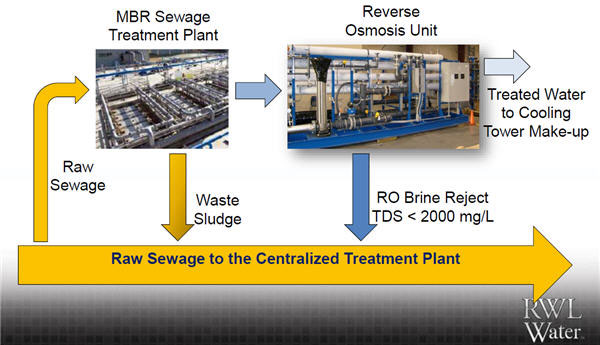Sewer Mining: An Unconventional Solution To Water Scarcity

By Kevin Westerling,
@KevinOnWater
‘Sewer mining’ may sound like a search for mistakenly flushed and washed-away valuables, but it’s actually a sophisticated, sustainable strategy for combating water scarcity. The practice combines two increasingly popular trends — decentralized water management and water reuse — by taking municipal wastewater from a trunk sewer and treating it on-site to accommodate a range of local, nonpotable water needs. Typically, the biosolids (sludge) can then be returned to the sewer for treatment at the downstream centralized facility, so long as there is adequate flow to keep the solids suspended.
The ideal candidate for sewer mining will: a.) prove cost-effectiveness versus alternatives; b.) have suitable nonpotable water needs — e.g., irrigation, industrial processing, toilet flushing, groundwater recharge; and c.) have enough municipal wastewater flow from the point of withdrawal to meet those needs. Local reuse regulations apply, of course, and the sludge and brine returned to the sewer must adhere to set municipal limitations on total dissolved solids (TDS) sent to the wastewater treatment plant (WWTP).
In Practice: A By-The-Numbers Case Study
The stars do (or at least can) align quite often for sewer mining, particularly in the U.S. West where population growth and energy demands continue to boom, even in the midst of historic drought.
In one example, a private developer of residential high-rise condominiums with 60,000 residents was spending $1.66 million per year for 300,000 GPD of potable water, used solely for cooling tower make-up water at the developer’s 40-MW power plant.
A number of options were considered to replace the expensive municipal water. They included:
- River water, which would require treatment for high salinity and high suspended solids, as well as transport to the power plant.
- Well water, which would require the developer to invest in well drilling and development.
- Rain water, which is unreliable and requires large tanks for storage.
- Treated wastewater, which would require long delivery pipes from the centralized WWTP.
- Raw sewage (i.e., sewer mining), which would require further treatment and has a municipal limitation of < 2,000 mg/L TDS for byproduct returned to the sewer.
After an initial assessment, the options were reduced to well water and sewer mining. The former, in this case, would require reverse osmosis (RO) treatment to reduce TDS, while the latter will always require biological treatment to break down the organics inherent in municipal wastewater.
To acquire 300,000 GPD of cooling tower make-up water, the RO system would demand 400,000 GPD of feed, resulting in 100,000 GPD of brine reject (at 44,000 mg/L TDS) — brine that could not legally be discharged to the river or sewer, nor deep-well injected.
Sewer mining became the sensible option, utilizing a membrane bioreactor (MBR) for raw sewage treatment combined with RO to achieve cooling-tower TDS requirements of 250 mg/L (with brine reject below 2,000 mg/L to comply with sewer discharge regulations). The solution is shown graphically below with an image supplied by RWL Water, which managed the project.

The result for this developer was a savings of $1,111,500 per year, as the cost of sewer mining came in at $548,500 compared to $1,660,000 for purchasing potable water. Here’s the breakdown of system stats and combined annual expenses:
- Total plant capacity: 300,000 GPD
- Treated sewage required: 352,940 GPD
- RO brine concentrate: 52,940 GPD
- RO brine concentrate characteristics: < 2,000 mg/L TDS
- Total project cost: $4.0 million
MBR Sewage Treatment Plant
- Capacity (raw sewage): 357,000 gallons
- Electrical consumption: 2,000 kWh/day
RO Plant
- RO Capacity:2 x 150,000 GPD
- Recovery: 85%
- Electrical Consumption: 682 kWh/day
Annual Costs
- Electricity @ $0.09/kWh: $88,104
- Chemicals and part-time labor: $75,000
- Equipment lease @5% APR over 15 years: $385,396
- Total annual cost: $548,500
At Work Elsewhere
MBR is a logical choice for many potential sewer mining applications because of its small footprint compared to conventional wastewater treatment — a smaller aeration basin, and no need for a secondary clarifier or filter. If space allows, however, conventional treatment works just the same. The North City Water Reclamation Plant (NCWRP), a satellite facility in San Diego, is one such example. NCWRP treats 30 MGD, lessening the load that would otherwise go to the Point Loma WWTP, and delivers it through the city’s “purple pipe” (recycled water) distribution network for irrigation and industrial use.
Elsewhere in California, the City of Anaheim has a sewer mining project at City Hall that is both practical and promotional. The 100,000-GPD Water Recycling Demonstration Facility, which utilizes MBR treatment (with ozonation and UV disinfection) to save space, is designed for public viewing and water reuse awareness. The water is used for local toilet flushing and irrigation at City Hall and other locations — but, moreover, it is used to teach a lesson: If drought is the “new normal,” we must all get comfortable with water reuse.
Centralized water reuse plants are essential going forward, in line with the transition from “wastewater treatment plants” to “water resource recovery facilities” (WRRFs), but they are huge capital investments that will only be constructed as existing plants become obsolete. In the meantime, sewer mining is a water reuse option and scarcity solution that’s within reach — right there at the pipeline.
